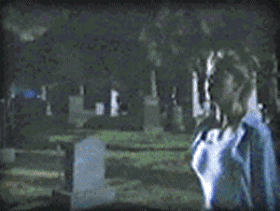
Who is who in the world of fright!
|
|
 Buffy
Buffy
|
|
 Silence of the Lambs
Silence of the Lambs
|
|
 Buffy The Vampire slayer
Buffy The Vampire slayer
|
|
 Bat
Bat
|
|
 Dracula
Dracula
|
|
 Idol Bat
Idol Bat
|
|
 Oh! No it's Dracula
Oh! No it's Dracula
|
Ever wonder which came first -- the bat or the vampire? How did bats become so associated with Count Dracula that the poor maligned creatures are forced to lurk in the recesses of twentieth-century popular culture? Is it all the fault of that Irish writer Bram Stoker and his novel DRACULA (1897)? Hopefully, the following paragraphs will answer these (and other) questions.
As all bat lovers know, there is a species known as the "vampire bat," the most common of which is "Desmodus rotundus." Found only in Mexico and parts of Central and South America, they feed primarily on the blood of livestock. A vampire bat will bite its prey with razor-sharp teeth while the prey is sleeping. Rather than suck the blood, it laps it up, much as a cat laps milk.
As for vampires (those blood-sucking monsters of fiction and film), these have "existed" since ancient times in the folklore and mythology of most cultures both in Europe and elsewhere. It appears that when the blood-lapping bats were first observed by Spanish explorers in Central and South America (their natural habitats), they were given the label "vampire" because of the fact that, unlike all other species of bats, these live off the blood of their prey.
Bats were associated with the mysterious and the supernatural long before Stoker's novel appeared in print. As creatures of the night, bats fit in well with the motifs of Gothic fiction. A bat-like vampire appears, for example, as an illustration in the novel VARNEY THE VAMPIRE, which appeared fifty years before DRACULA.
But it is Bram Stoker's novel that cemented the connection between bats and the vampires of folklore. While he was working on his novel in the 1890s, Stoker came across a clipping in a New York newspaper concerning vampire bats which directly influenced the following comment by Quincey Morris in DRACULA: "I have not seen anything pulled down so quick since I was on the Pampas and had a mare ... One of those big bats that they call 'vampires' had got at her during the night and ... there wasn't enough blood in her to let her stand up." Stoker obviously did not know (or chose to ignore) the fact that the vampire bat is quite small.
But Stoker's major contribution to the association of vampires with bats was his introduction of the idea that a vampire could shapeshift into the form of a bat (as well as a wolf and mist). For example, in his pursuit and seduction of Lucy, Count Dracula frequently disguises himself in the form of a large bat which flaps at her window. In Stoker's novel such a "vampire bat" is, of course, quite capable of attacking and draining humans.
This motif found its way into the movies. While the first film based on DRACULA, "Nosferatu" (1922) did not use bats (here the connection was with rats), the 1931 classic Universal Studios "Dracula" starring Bela Lugosi certainly did. This was the movie that provided the twentieth century with its most memorable and lasting images of Count Dracula (including the bats), images that survive to this very day.
Even the medical community has latched on to the Dracula-bat connection! A Venezuelan research team have isolated a previously unknown anticoagulant glycoprotein from Desmodus rotundus (the common vampire bat). This substance targets activated forms of blood coagulation factors, thus inhibiting them immediately. Named "draculin," this anticoagulant agent promises to be significant in the development of improved drugs to fight heart disease and stroke.
Bram Stoker would certainly be amazed!
|
 BATS, VAMPIRES, AND DRACULA
BATS, VAMPIRES, AND DRACULA
|
Living Dead
|
Top
|